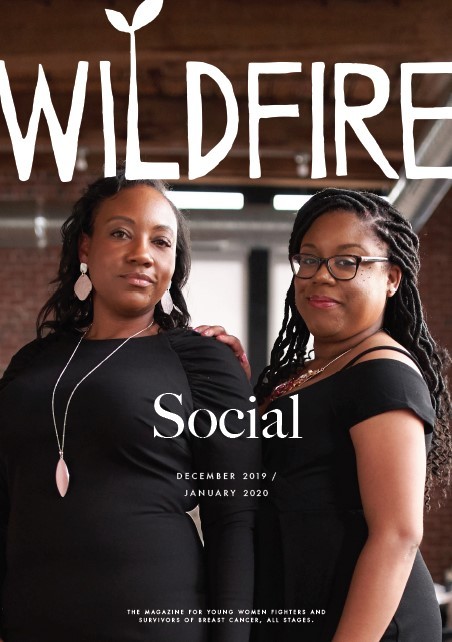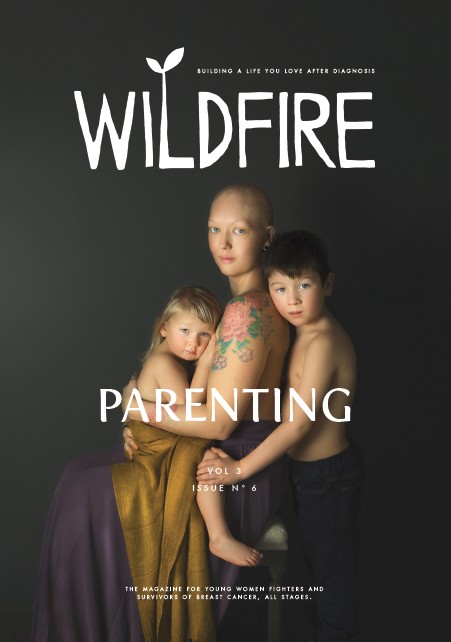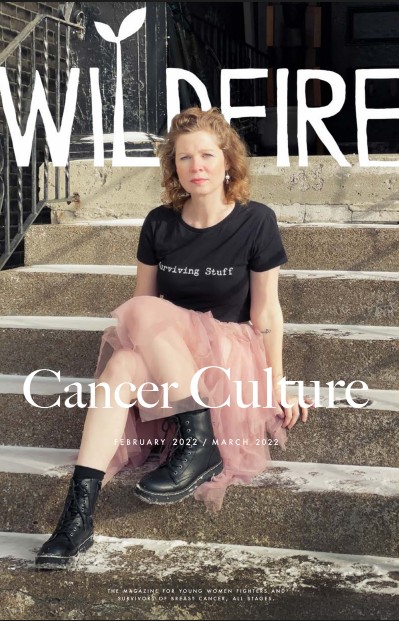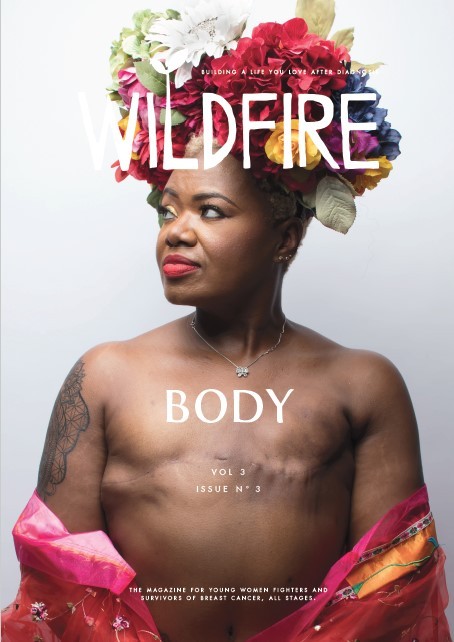We were lucky to catch up with April Stearns recently and have shared our conversation below.
April, thanks for taking the time to share your stories with us today So, naming is such a challenge. How did you come up with the name of your brand?
It was the summer of 2015. I was 38 years old and 3 years out from a Stage 3 breast cancer diagnosis. I’d just spent the last 18 months of my life caring for my dad as he was dying from pancreatic cancer and then settling his estate and selling my childhood home following his death. I had quit my job in event planning in order to care for my dad and found myself at a crossroads: I could go back to event planning, but I found myself to be utterly changed from my own experience of cancer and the grief of losing my dad. I was struggling to understand how anyone moved on after such devestation.
When I was diagnosed with cancer at 35, everyone around me told me that cancer would be just a little detour, a speed bump on the path of my life. But 3 years later, it didn’t feel like just a detour. It felt like the main, pot-hole filled road. I was an entirely different person than I was prior to diagnosis, and I couldn’t find away back to who I was before.
Growing up, my dad instilled in me a strong work ethic. By day, he worked at IBM in Silicon Valley. At night and on weekends, he was the chief of the volunteer fire department for our mountain community. He volunteered as a firefighter every single day tirelessly for 31 years. In that time, he taught me a lot about not only community service, but also about fire. Next to earthquakes, fire was the big fear for us living in the Santa Cruz Mountains. My dad fought a lot of fires over the years, from car fires to house fires to wildland and forest fires.
Following our twin cancer diagnoses, I found myself thinking a lot about forest fires because what he taught me was that fire seemed like the worst possible thing: it burned hot and fast, leaving a wake of destruction behind it. It killed everything. But my dad taught me that that wasn’t entirely true. Given a little time in the aftermath, fire can actually pave a way for new growth to emerge in the sunlight that can now reach the forest floor. Fire can be a clarifying event.
I came to see my cancer diagnosis as a clarifying event. It helped me focus in on what mattered to me most. I wanted to create a resource that would help others look at their lives post-cancer through that lens, too. In 2016, I launched a magazine I called “Wildfire” for the young breast cancer community. Since then, it has become a place for people diagnosed with breast cancer under 50 to explore life and transformation following what we thought was the worst possible thing that could ever happen to us.


Great, appreciate you sharing that with us. Before we ask you to share more of your insights, can you take a moment to introduce yourself and how you got to where you are today to our readers
My breast cancer diagnosis at 35 took me, my family, my colleagues, my friends, and my doctors by surprise (and even now, no known genetic explanation has been found). I spent 13 months in active cancer treatment. I’m a rule follower and a people-pleaser, so it made me feel really good after the dust of the diagnosis phase had settled that my new oncology team said, “Here’s the path through cancer.” I put my head down and for 13 months I endured round and round of chemotherapy followed by a unilateral mastectomy followed by round afer round of radiation followed by more targeted intravenous therapy. At the end, I was declared NED (no evidence of disease – what used to be called remission) and told to go live my life. Hooray!
And then, life got real hard.
When I had a treatment path, I knew what was expected of me. That doesn’t mean it was easy, it simply means I didn’t have to do a lot of thinking about it. After treatment ended, that path evaporated and with it my frequent check-ins with my medical team. It was as if my body and my life were handed back to me but I no longer recognized either. All around
me, my friends and family rejoiced. “You beat cancer!” they said. So why did I feel so lost? Why weren’t things bouncing back to normal? Why was I was sad?
In this time, I turned to writing to process my dad’s sudden death and my own sorrow at my cancer experience and brokenness in the aftermath. I had always used writing to make sense of the big traumas in my life, so here I was again asking, “What just happened?!” and hoping that if I could answer that question perhaps I’d understand what (and how) to move beyond it. I understood on a big level what had happened, of course. I knew what my medical chart said (Stage 3c
HER2+ invasive ductal carcinoma). But now I needed to put it in my own terms in order to understand on a mico level what had occurred. What had I endured and assimilated each day that passed since diagnosis?
This dark time was 11 years ago for me now, and I now know I was not alone in feeling lost after my cancer was declared eradicated. I know now that for many, it is the time long after diagnosis and the whirlwind of treatment subsides, when the dust has settled a bit, that can actually be the hardest. For me, the hardest was years 2-4 after diagnosis. I didn’t recognize
my body, I didn’t know what I wanted from life anymore, and I was terrified of the cancer returning, especially with
my doctors no longer monitoring me closely.
I also had yet to meet anyone else diagnosed young. It was in this time that I took a memoir writing workshop and finally met my first friend also diagnosed young. The recognition I felt upon hearing her cancer stories and seeing similiar scars on her body as I carry on mine took my breath away and filled me with such a feeling of wholeness. She didn’t have all the
answers to the questions I was asking. Instead, to know that she was out there asking the same questions, that was the balm my soul needed. That was enough to feel I could keep going.
Soon after meeting her, in 2015 I got the idea to launch WILDFIRE Magazine so others could feel what I felt upon hearing another’s breast cancer story. I began small, publishing a handful of stories every other month but it grew issue by issue and at the time I’m writing this, I now have published 41 issues, each with close to 30 writers.
In 2020, as the world slowed down and we went into lockdowns for Covid-19, I began holding memoir-writing workshops for the young breast cancer community. One by one, we began to turn on our webcams and find one another on our screens and in our journals. We could connect despite the pandemic, despite cancer, from our bedrooms and sofas. We could write together to make sense of what we were experiencing.
It is my firm belief that reading and writing stories – be they cancery or otherwise – has the power to transform a traumatic experience into an experience of meaning.
Today WILDFIRE is a magazine, podcast, and writing community.


Any insights you can share with us about how you built up your social media presence?
To be honest, social media has been one of the hardest aspects of running my business and it has taken 8 years to reach 10K followers on Instagram. I don’t have any advice for growing an audience quickly, but what I do have because of growing slowly and intentionally, is a loyal and engaged audience of eager customers. For many years, I managed my social media myself and while I have help with my account now, I still spend a lot of time on my Instagram myself. I have learned over the years that people want to know who is behind a brand. They want to connect to real people to whom they can relate. So I have not shied away from being transparent in my business. I have allowed my followers to see the triumphs as well as the struggles. I have gotten to know their names and their stories, too. It truly feels like a community, not just a marketing devise. My advice for anyone just starting out is be yourself. Don’t be afraid to put your face on your social media, to talk about the things that really matter to you. People can tell when you are holding them at arm’s length or trying to be “professional.” They’d rather get to know the real you, and thus your business.
Do you have any insights you can share related to maintaining high team morale?
First and foremost, be a good listener. Hear your team members when they have ideas and suggestions, or when things are hard. Second, be approachable and part of the team. Be yourself and let yourself be known. Finally, I think it has really helped me to hire from within the community I serve and to hire people who were already fans of the work I do. I didn’t have to convert them or sell them on the value of our product or the need for it within the breast cancer community.
Contact Info:
- Website: wildfirecommunity.org
- Instagram: wildfire_bc_magazine
- Facebook: wildfirecommunity
- Linkedin: aprilstearns
- Twitter: real_wildfire
Image Credits
Headshot: Missy Peters | Breast Cancer Portrait Project


